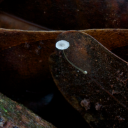
What is the fate of dead wood and fallen leaves? A large fraction of a forest’s carbon is stored in these materials at any given time. But this dead material does not continually accrete – it is transformed into other forms by decomposers, and made available to other organisms. Large logs may last for only a few years before apparently disappearing, and leaves may disintegrate over weeks. The lignin and cellulose in plant tissue is effectively locked up and unavailable to most organisms without decomposers. Insects, microbes, and fungi play a key role in this recycling process.

This forest has very few large mushrooms – the fruiting bodies (reproductive structures) of fungi. Apparently the large populations of snails and insects rapidly eat them. However, if you look up close enough you will find large numbers of very small fungi, in many shapes and colors. Most of the mass and life of a fungus is spent in a non-reproductive state, where intricate filaments of cells probe into wood and leaf to extract resources. Only rarely do these fruiting bodies appear, as the fungi reproduce and disperse. We are lucky to get an up-close view of this hidden world!


Comments
4 responses to “Fungal bestiary”
The top ones look like little angry fists!
Transparent little fists!
Incredible pictures, Ben! Keep em coming.
Thanks Will!